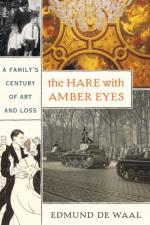
|
| Name: _________________________ | Period: ___________________ |
This test consists of 15 multiple choice questions and 5 short answer questions.
Multiple Choice Questions
1. What is the title of Chapter 24?
(a) An Ideal Spot for Mass Marches.
(b) Looting the City.
(c) Waiting for Disaster.
(d) Flying to a New Destiny.
2. What is the title of Chapter 20?
(a) Life peetering away.
(b) Hail Wein! Heil Berlin!
(c) Frothing at the Mouth.
(d) Hail Life as We Know it.
3. What instrument does Henrik de Waal play?
(a) Fiddle.
(b) Guitar.
(c) Trumpet.
(d) Violin.
4. What did Charles leave Emmy in his will?
(a) A diamond ring.
(b) A Rimbaud painting.
(c) His book collection.
(d) A gold necklace.
5. Where are the three cities the author travels to in the Coda section?
(a) Tokoyo, Odessa, London.
(b) Vienna, Kyoto, St. Petersburg.
(c) Birmingham, Berlin, Munich.
(d) Paris, Moscow, Vienna.
6. What philosopher did Emmy call a bear with the manners of a bear?
(a) Russell.
(b) Freud.
(c) Nietszche.
(d) Klimt.
7. Where is the chest from that the wooden Buddha in Iggy's house sits on?
(a) Austria.
(b) Korea.
(c) Britain.
(d) Russia.
8. What two countries had Iggy been offered placements in?
(a) China and Japan.
(b) Britain and Korea.
(c) Vietnam and Brazil.
(d) Japan and Congo.
9. What does Richter and Henker translate to in English?
(a) Poets and thinkers.
(b) Judges and hangmen.
(c) Lovers and murderers.
(d) Fighters and cowards.
10. What is Pips doing on the pen and ink card?
(a) Writing his memoirs.
(b) Dancing.
(c) Playing the piano.
(d) Bowing to the ladies.
11. Who is Elisabeth named after?
(a) An empress.
(b) A queen.
(c) A psychologist.
(d) A writer.
12. Who was appointed the German Chancellor in 1933?
(a) Heller.
(b) Bismarck.
(c) Schiller.
(d) Hitler.
13. In which city was Viktor born?
(a) Berlin.
(b) Odessa.
(c) Paris.
(d) Vienna.
14. Why kind of parties did Iggy find very boring?
(a) Geisha parties.
(b) Go Go parties.
(c) Family parties.
(d) Peep Show parties.
15. Which of the following phrases were printed in the Japanese-English Conversation Manual?
(a) Give my love to the queen.
(b) Blimely, where are we?
(c) Looky here.
(d) Thank you, awfully.
Short Answer Questions
1. Who does Elisabeth write a letter to in Chapter 20?
2. What does the author call a tonic at the beginning of Chapter 17?
3. Why did the Japanese decide to accept the Pan Pan girls?
4. What do Mussolini, Chamberlain and Daladier sign on September 30th?
5. Which country do the Ephrussi go to for their long month away?
|
This section contains 386 words (approx. 2 pages at 300 words per page) |

|




